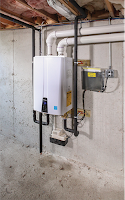 |
| Navien Tankless Water heater installed by Prestige Plumbing |
Descaling is an important part of tankless hot water heater maintenance. While you don't need to do it monthly, or even yearly, it should be done no less than two years. When a tankless water heater warms water, something called dissolved solids are left behind. Over time, these solids build up in your water heater and can poorly affect the flow and efficiency. In extreme cases, your how water may even overheat leading to major repairs being needed. So how to do descale your tankless water heater? You'll need a few items:
1. A System Descaler - Generally this is composed of a pump, bucket, and a few hoses.
2. Descaling Solution - You will want to ensure this is food safe and biodegradable.
3. Proper Valving - Most of the time this is no worry when your tankless water heater is installed by a professional, but making sure the correct valves are installed it crucial. If you aren't sure or think something is missing, call a professional at Prestige Plumbing.
While some homeowners choose to descale their tankless water heater by themselves, some prefer to call a professional plumber like Prestige Plumbing to help. If you want to tackle the tankless water heater descaling, the steps below can help you fully take care of the maintenance.
1. Turn off water valves. This helps stop any water from pouring out of your tankless water heater.
2. Removed hose threads from the hot and cold water ports.
3. Take the Hose from your system descaler and attache it to the hot valve. Place the other end of this hose in your bucket.
4. Attach the hose that is connected to your system decaler pump to the cold valve.
5. Turn the water back on.
6. Turn the hot water on and let the water flow freely into the bucket. Only fill the bucket with enough water to submerge the pump and then turn the water off.
7. Add the descaling solution to the water in the bucket.
8. Make sure all hoses are connected and turn on the secondary tap. You can turn the gas flow off to stop this water from being heated as it passes through the tankless water heater.
Now your fully ready to start the descaling steps!
1. Turn the pump on and let it run for about an hour.
2. Turn off the pump, turn off the inlet valves, and remove the hoses.
3. Turn the hot water valve back on and allow any water to run out.
4.commonly found on the underside of tankless water heaters, there is a small screen that can be unscrewed. You should unscrew this and make sure that it is now clean.
5. Rinse the screen to rid any leftover solution and any remaining debris.
Congrats! Your tankless hot water heater is now descaled! There are just a few remaining steps to reestablish clean water flow.
1. Reattach the hose to the hot side of the system, but leave the isolation valve off.
2. Turn on the cold water to begin pressurizing the system.
3. Turn the hot water hose port on, and then turn the gas back on. Let water freely flow through the tankless hot water heater until it is warm.
4. Turn the valve off and remove your hose.
5. Replace the cover to the hot water valve and turn the isolation valve back to the on position.
6. Make one final check that the gas is on, both hose ports are off, and both isolation valves are on.
While it might look like this is a lot of work, it is very very important work for the longevity of your tankless hot water heater. Prestige Plumbing can help you with tankless hot water heater and plumbing maintenance so you can relax knowing your plumbing is taken care of.
Comments
Post a Comment